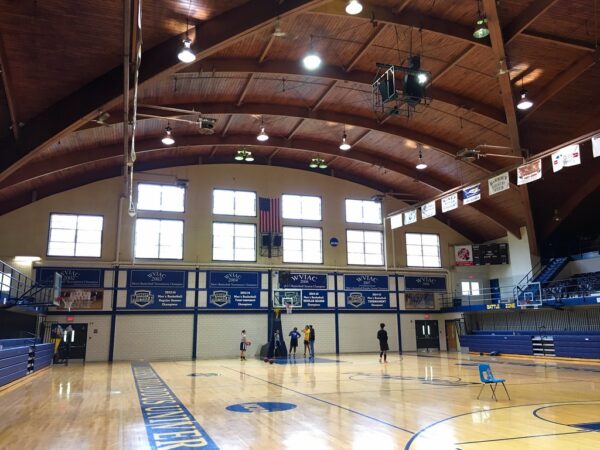Urbana University’s closing put the Mountain East Conference into search mode.
Ashland University’s joining of the Great Midwest Athletic Conference (G-MAC) may turn that search into salvage.
No, the MEC is not in danger. The conference is still 11 members strong, and while football may have brought it together, basketball is the feather in its cap.
But league commissioner Reid Amos stated previously to post-Urbana’s closure that an Ohio presence is paramount to the conference’s plans.
“An Ohio presence for our conference is something that we value greatly. To lose Urbana University is saddening to all of us, but it’s the reality of the impact that this pandemic is having economically,” Amos said in an earlier interview with WBOY in Clarksburg.
Amos declined an interview request for this story, but MEC Senior Associate Commissioner for Communications, Adam Zundell, noted that, “At this time, the league doesn’t have a comment on membership or potential members.”
Ashland may or may not have been at the top of the MEC wish list, but its exodus from the Great Lakes Intercollegiate Athletic Conference for the G-MAC will have a ripple effect.
Two members schools from Ohio gave the MEC a solid foothold in the Buckeye State. One? Well, it’s more like a toehold. And it’s slipping.
Notre Dame now stands with Central State University as the only two Division II programs in Ohio not joined with the G-MAC.
What’s between the town of South Euclid and Ohio County, where the two closest members MEC members are found? Six G-MACs schools in closer proximity.
Google maps has West Liberty 144 miles apart and Wheeling 149. The G-MAC has six schools at 107 miles or less, but four total are shorter than three-hour trips. In the MEC that number dwindles to two.

Why Ashland Would Have Worked
The GLIAC is one of the top conferences in Division II, and Ashland played a significant role in that. The women’s basketball team has two national titles to its credit and was on its way to a third this season before the coronavirus wrecked the party.
The Eagles at one point finished in the Top 10 of the Director’s Cup standings for all of Division II for eight consecutive school years, including second in 2014-15. Ashland knows how to win.
It was content in the GLIAC. But travel costs and athletic department budgets are under increased scrutiny during the pandemic, and that isn’t going to change anytime soon. Distance and basketball strength could have made the MEC a worthwhile opportunity.
The GLIAC is comprised mostly of Michigan schools. Ashland’s average round-trip trek for road games in the GLIAC was 730.9 miles (11 schools, total of 8040 miles for one back-and-forth trip each). In the MEC, that number dropped to 538.4 and that’s including UNC-Pembroke.
The MEC had three one-way trips fewer than 150 miles. The shortest drive in the GLIAC was 151 to Wayne State in Detroit. The 319-mile one-way trip to Concord was still better than five of the GLIAC’s lengthiest trips.
But while the MEC’s travel upgrade was a sizable discount, it pales in comparison to that of the G-MAC, with eight members schools within a “day-trip” driving radius.
That’s a major cost savings in the travel budget. Also, once spectators can return post-social distancing, proximity will allow visiting fan bases to travel and should increase game attendance.

Why Ashland to the G-MAC is Problematic
There’s no guarantee Ashland would have been receptive to an invitation to join the MEC. But on proximity alone, it at least would have entertained the offer.
But this move leaves the MEC with three options in relation to the opening in its membership ranks, and none are promising.
There’s one Ohio school left not already in the MEC or G-MAC, and that is Central State University. CSU is the only public Historically Black Colleges and Universities (HBCU) institution in Ohio. It joined the Southern Intercollegiate Athletic Conference (SIAC) fully in 2015.
Travel-wise, the MEC is a much better fit than the SIAC for CSU. But so was CSU’s former conference—the G-MAC. The SIAC has 14 members colleges and universities, all but one (Spring Hill College) are also HBCUs. If proximity wasn’t enough to keep CSU in the G-MAC, the MEC won’t be able to use that as a bargaining chip.
The second option is trying to pry an Ohio-based member away from the G-MAC. Ohio Dominican perhaps? Maybe Lake Erie, which would give NDC a natural rival right down the road in Painesville?
But again, we come back to proximity. Why increase travel costs now, especially when the conference was just strengthened by the addition of one of Division II’s top overall programs?
That leaves the third option: adding a team not from Ohio. Sure, this would bring the conference membership back to 12. But it leaves Notre Dame on an island. How long do you think the athletic leadership at NDC will sit on that island with the G-MAC party boat cruising by and blasting its horn, beckoning with its short drives and more natural rivalries?

Other Options Part I: The PSAC
So, what, or particularly who, is left for the MEC to pursue? Conference leadership also expressed interest in a replacement preferably field football. So, let’s start there.
The most recent team to leave the MEC, save for Urbana, was Shepherd. The Rams were a long-time MEC and former WVIAC member which left for the greener gridiron pastures of the Pennsylvania State Athletic Conference. A return is highly unlikely.
The same can be said for fellow recent defectee, the University of Virginia College Wise, which left in 2018 for the South Atlantic Conference. The UVA-W leadership commented that the SAC had a better geographic footprint. So again, a return is unlikely.
But let’s stick with PSAC for a second.
Seton Hill and non-football playing University of Pitt-Johnstown were members of the WVIAC when the MEC was formed. The two opted to join the PSAC, also one of the top conferences in Division II and the regional bellwether for football.
But the Griffins time in the PSAC has been anything but easy. Save for the baseball program, which has two conference championships, and the volleyball team’s crown in 2017, winning seasons are tough to come by. Since joining in 2013, the Griffins’ football team has gone 15-61, with its best effort a 5-6 record in 2016. The top teams in the conference—California, IUP, Slippery Rock and now Shepherd — are hammering the Griffins with regularity.
Might the Griffins be lured away with a slightly more favorable football climate in the MEC? There are already built-in relationships from the WVIAC days.

Other Options Part II: Former WVIAC Members
There are grumblings about further G-MAC movement here in the coming weeks, whether that means additions or subtractions, at this point is speculation.
But if teams are leaving, might it be former WVIAC members Alderson-Broaddus and Ohio Valley?
OVU is out as it doesn’t have football, nor does it hold up to MEC Bylaws’ enrollment amount stipulation. But Alderson-Broaddus could work, provided the conference and school’s leadership can find common ground.
Distance-wise, it works. The university has built-in history with member schools. A major problem, however, is the condition of A-B’s basketball complex. The Rex Pyles Arena needs major repairs and upgrades. The facility closed for just that reason during the season, even before the pandemic shut everything down. A-B was forced to play a game at the McConnell Center in Elkins.
Another option, and one that has expressed interest in joining the fold, is Bluefield State. Like Salem, Bluefield is a W.Va. school currently lacking a football program, and a conference home. But unlike Salem, Bluefield does meet the enrollment requirements.
There is also plenty of talk about the Big Blues adding back its football program, which last played in 1981.
The college’s first on-campus housing since 1968 is set to be completed by December of 2020 and will house roughly 120 students according to a story in the Bluefield Daily Telegraph.
What better reason than to house an influx of athletes for its new program? Without football, Bluefield could still join but would need to add three more championship-playing sports for consideration: men’s and women’s soccer and most likely women’s golf.
Changes are coming to the MEC no matter which direction the conference takes. The question is, who will join, and who will remain?




